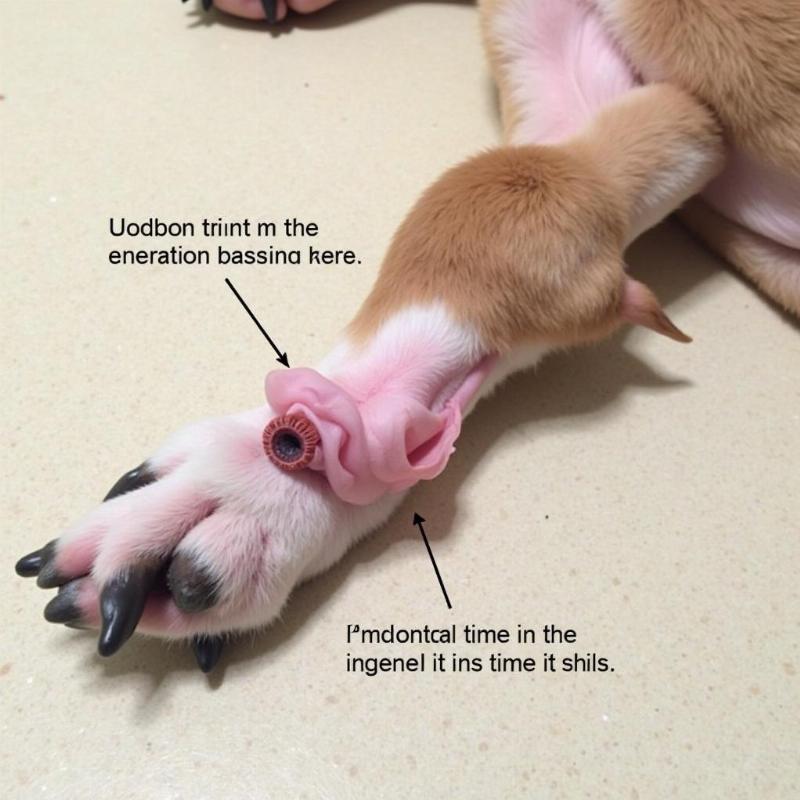Urethral prolapse in male dogs, while uncommon, is a concerning condition where the inner lining of the urethra protrudes from the penile opening. Understanding the underlying causes of this issue is crucial for effective prevention and treatment. This article will delve into the factors that can contribute to urethral prolapse, discuss common symptoms, and outline available treatment options in the US.
While the exact cause of urethral prolapse isn’t always clear, several factors are thought to increase the risk. Hormonal influences, particularly excessive testosterone, can play a significant role. This is why the condition is more commonly observed in intact male dogs, especially certain breeds like Bulldogs, Boston Terriers, and Pugs. Other contributing factors can include urinary tract infections, straining during urination, excessive licking or chewing of the area, and occasionally, tumors or anatomical abnormalities.
Recognizing the Signs of Urethral Prolapse
 Symptoms of Urethral Prolapse in Dogs
Symptoms of Urethral Prolapse in Dogs
The most obvious symptom of urethral prolapse is a small, donut-shaped, reddish mass protruding from the tip of the penis. This protruding tissue can be mistaken for a tumor or other growth. Often, the dog will lick the area excessively, and you may notice blood in the urine or on bedding. If you observe any of these signs, it’s crucial to seek veterinary attention immediately.
Treatment Options and Long-Term Management
Treatment for urethral prolapse depends on the severity of the condition. In some cases, topical medications and antibiotics may be sufficient to reduce inflammation and address any underlying infections. However, surgical intervention is often necessary to correct the prolapse and prevent recurrence. Castration is typically recommended to minimize the influence of testosterone and reduce the likelihood of future prolapses.
Importance of Prompt Veterinary Care
Seeking prompt veterinary care is vital for managing urethral prolapse effectively. Early diagnosis and intervention can prevent complications such as infection, necrosis (tissue death), and urinary obstruction. Your veterinarian can determine the appropriate treatment course based on your dog’s specific situation.
Preventing Urethral Prolapse
While not all cases of urethral prolapse are preventable, certain measures can reduce the risk, particularly neutering male dogs. Maintaining good hygiene around the genital area and addressing urinary tract infections promptly can also help. Regular veterinary checkups allow for early detection of any potential issues.
“Neutering is one of the most effective ways to prevent urethral prolapse, especially in breeds prone to the condition,” advises Dr. Emily Carter, DVM, a leading veterinarian in New York City. “It significantly reduces the hormonal influence that can contribute to this issue.”
“Early intervention is key,” adds Dr. David Miller, DVM, a board-certified veterinary surgeon in Los Angeles. “If you notice any abnormalities in your dog’s genital area, don’t hesitate to contact your veterinarian. Timely treatment can significantly improve the outcome.”
In conclusion, urethral prolapse in male dogs is a serious condition requiring prompt veterinary attention. Understanding the causes, recognizing the symptoms, and seeking appropriate treatment can help ensure the best possible outcome for your furry companion. Remember, early intervention is key to managing this condition effectively and preventing long-term complications.
FAQs
- What breeds are most susceptible to urethral prolapse? Bulldogs, Boston Terriers, and Pugs are among the breeds most commonly affected.
- Is urethral prolapse painful for dogs? Yes, it can cause discomfort and pain, leading to excessive licking and chewing of the area.
- Can urethral prolapse reoccur after treatment? Recurrence is possible, especially if the underlying cause isn’t addressed. Neutering significantly reduces the risk of recurrence.
- What is the typical recovery time after surgery for urethral prolapse? Recovery typically takes several weeks, and close monitoring is necessary to prevent complications.
- What are the long-term implications of untreated urethral prolapse? Untreated prolapse can lead to infection, necrosis, and urinary obstruction, which can be life-threatening.
- How much does treatment for urethral prolapse typically cost in the US? The cost can vary depending on the severity and required treatment, typically ranging from a few hundred to over a thousand dollars.
- Are there any home remedies for urethral prolapse in dogs? No, home remedies are not recommended. It’s crucial to seek professional veterinary care for diagnosis and treatment.
Related Articles:
prolapsed urethra in male dogs
urethral prolapse in male dogs
About Beautdogs.us: Beautdogs.us is your premier source for comprehensive dog care information in the US. We offer expert advice on dog breeds, grooming, nutrition, training, and health. From puppyhood to senior care, we provide reliable resources for both new and experienced dog owners. For personalized guidance or any dog-related inquiries, contact us at [email protected] or call us at +1 501-555-7529.